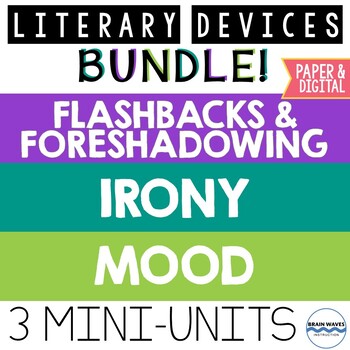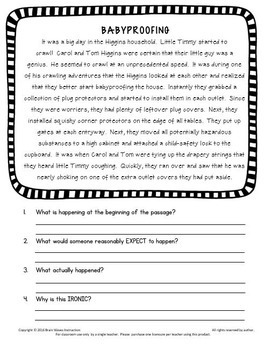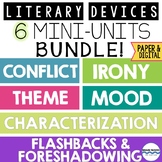Literary Devices Mini-Units: Mood, Foreshadowing & Flashback, Irony (Digital)
- Zip
- Google Apps™

What educators are saying
Products in this Bundle (3)
Also included in
- Save BIG with this bundle of LITERARY DEVICES mini-units --- Theme, Conflict, Characterization, Irony, Mood, Flashbacks and Foreshadowing!This bundle includes SIX 3-day mini-units!Great News! The student packet in each mini-unit is also available as a Google Slides resource for students. In additionPrice $27.99Original Price $32.94Save $4.95
Description
This bundle includes three 3-day mini-units on Mood, Foreshadowing & Flashbacks, and Irony!
Great News! The student packets in each mini-unit are also available as a Google Slides resources. In addition to the PDF version, students can complete the packet pages via a file sharing service such as Google Drive, Google Classroom, or in the internet “cloud.” The digital version of the packet is accessible from any computer and allows students to complete their work online.
* FYI: The anticipatory set activities that accompany each lesson are NOT in a digital format. They will still need to be printed for students due to the hands-on and interactive nature of the activities.
--------------------------------------------------------------------------------------------------------------
Irony Mini-Unit
Help students develop a deep understanding of situational, dramatic, and verbal irony with this fun and engaging 3-day mini-unit.
This IRONY MINI-UNIT provides numerous opportunities for students to learn about the three types of irony, determine the purpose of irony, analyze irony, describe how irony contributes to a story and even write their own examples of irony. Each lesson starts with a fun and engaging activity – Irony Hunt (where students differentiate between examples of irony and just bad luck while rotating around the classroom), Types of Irony – Tri-Fold Cards (where students create flippable cards for the types of irony that they flip in response to ironic situations), and Irony Flip Cards (where students create interactive flip shapes, create irony, and then explain it). Then, students learn about and practice understanding irony through whole group instruction, small group work, partnerships, and independent practice.
In this mini-unit, students will develop a deep understanding of literary devices, situational, dramatic, and verbal irony. Students will complete guided notes, reading comprehension passages, graphic organizers and writing activities. In addition, they’ll practice identifying irony while reading short and long reading passages. This is a fun unit for students and teachers!
The detailed IRONY mini-unit includes:
• 3 Detailed Daily Lesson Plans
• Irony Hunt Tracking Sheet
• 10 Irony Hunt Task Cards
• Irony Clues (for teacher read aloud)
• Types of Irony Tri-Fold Cards
• Irony Flip Cards (with sentence starters)
• Irony Flip Cards (with blanks)
• Irony Explanation Templates
• Literary Devices and Irony Guided Notes
• Three Practice Reading Passages with Comprehension Questions
• Finish the Story – Writing Activity
• Types of Irony Guided Notes
• Make it Ironic Activity
• Irony Types Partner Activity
• Breaking News – Irony Headlines and Analysis
• Long Reading Passage and Reading Comprehension Questions
• All keys for student work and instruction
--------------------------------------------------------------------------------------------------------------
Flashback and Foreshadowing Mini-Unit
Foreshadowing and flashbacks are critical literary techniques that authors use to pull readers into the reality of the story and reveal its characters. These drama-heightening techniques are essential for students to understand as they develop their craft as readers. This 3-day mini-unit is designed to help students develop a deep understanding of both foreshadowing and flashbacks.
This Foreshadowing and Flashbacks Mini-Unit provides numerous opportunities to help students understand and analyze both literary devices. Each lesson starts with a fun and engaging activity – Nursery Rhymes Foreshadowing Foldable, Personal Flashbacks, and Foreshadowing vs. Flashback Sort. Then, students learn about and practice identifying the literary elements through whole group instruction, small group work, partnerships, and independent practice.
In this mini-unit, students will develop a deep understanding of chronological order, foreshadowing, and flashbacks. Students will complete guided notes, reading comprehension passages, graphic organizers and writing activities. This is a fun unit for students and teachers!
The detailed FORESHADOWING AND FLASHBACKS mini-unit includes:
• 3 Detailed Daily Lesson Plans
• Foreshadowing Shapes and Statements for Nursery Rhymes
• Altered Nursery Rhymes Activity
• Personal Flashbacks Activity
• Flashbacks vs. Foreshadowing Chart
• Flashbacks vs. Foreshadowing Sorting Activity
• Guided Notes on Foreshadowing
• 3 Short Reading Passages and Questions for Foreshadowing
• What Happens Next – Prediction Activity
• Guided Notes on Flashbacks
• 3 Reading Passages and Questions for Flashbacks
• Find the Flashback Activity
• Guided Notes on Chronological Order
• Long Reading Passage with both Foreshadowing and Flashbacks
• Reading Comprehension Questions
• Writing & Foreshadowing Activity
• Writing a Flashback Activity
• All keys for student work and instruction
--------------------------------------------------------------------------------------------------------------
Mood Mini-Unit
Mood is an essential element of every piece of literature. That’s why helping students to understand how to distinguish and analyze the mood of a text is essential. This mini-unit is designed to do just that! Not only will students understand how the mood is the feeling or atmosphere that a piece of writing creates, they’ll also develop confidence in their own skills as a reader.
This 3-day mini-unit provides lots of opportunities for students to read, write, and discuss mood. Each lesson starts with a fun and engaging activity – Emoji Moods (where students hold up emoji faces in response to teacher clues) – Many Moods Foldable (where students sort jumbled moods into an interactive shape) – Mood Sketch and Write (where students sketch 4 moody scenes and then describe them). Then, students learn about and practice identifying the mood in literature through whole group instruction, small group work, partnerships, and independent practice.
In this mini-unit, students will develop a deep understanding of how mood can be developed with word choice and setting. They’ll also analyze long and short reading passages as well as poetry. Students will complete guided notes, reading comprehension passages, graphic organizers and writing activities. This is a fun unit for students and teachers!
The detailed MOOD mini-unit includes:
• 3 Detailed Daily Lesson Plans
• Emoji Moods – Happy and Depressed Hands-On Shapes
• Emoji Moods – Clue Sentences
• Many Moods Foldable – Story Cards
• Many Moods Foldable – Interactive Shape
• 4 Mood Sketch and Write Activities
• Guided Notes on Literary Devices and Mood
• 3 Short Reading Passages and Questions for Mood
• What a Mood – Writing Activity
• Guided Notes on Mood and Word Choice
• Poetry and Mood Analysis – with 3 Analysis Tasks
• Guided Notes on Mood and Setting
• Long Reading Passage
• All keys for student work and instruction
GREAT NEWS! You can find additional bundles of these mini-units here:
• Theme, Conflict, and Characterization Mini-Units
You may also like…
• Listening Comprehension Unit
• 20 Daily Warm Ups - Engaging and Educational Bell Ringers
Following is Fun!
Get the inside scoop on all store discounts, free products, and product launches. Just click the green “Follow Me” star under my store name on this page or click the green “Follow Me” star on my store homepage.
*** Click HERE to receive the Brain Waves Instruction Newsletter filled with exclusive FREEBIES and Teaching Tips!
*** Click HERE to become a seller on TpT (Referral by Brain Waves Instruction)
Thanks!
Brain Waves Instruction






